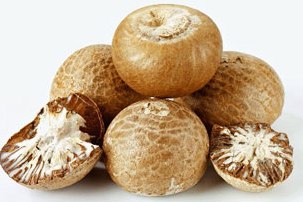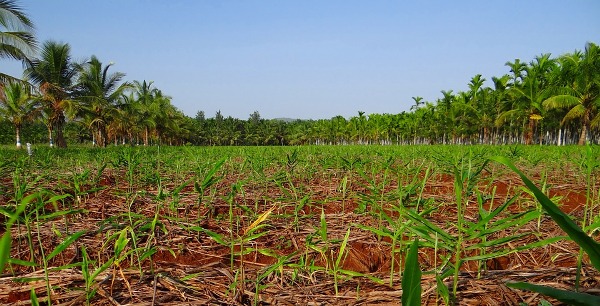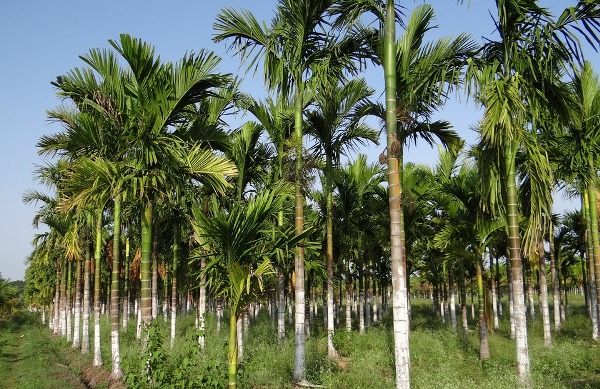Arecanut Production for Beginners:
Introduction to Arecanut Production:- The Arecanut is that the seed of the areca palm, which grows in much of the tropical Pacific, Southeast and South Asia, and parts of east Africa. This seed is commonly called betel nut or supari. The Arecanut isn’t a true nut, but instead, a fruit categorized as a berry. It is commercially available in dried, treated, and fresh forms. After the husk of the new fruit is green, then the nut inside is tender enough to be cut with a normal knife. From the mature fruit, the husk becomes yellow or orange and, as it dries, the fruit inside hardens into a wood-like consistency.
Scientific Name / Botanical Name of Arecanut:- Areca catechu, Piper betle.
Family Name of Arecaunut :- Arecaceae.
Genus of Arecaunut :- Areca.
Common Name of Arecaunut:- Betel Nut, Supari.
Other Country Names of Arecanut:-
- Nepali: Supari.
- Indonesian: Pinang.
- Javanese: Jambe.
- Lao: Mark.
- Malay: Pinang.
- Sanskrit: Poogi phalam.
- Sindhi: Sopari.
- Sinhalese: Puwak.
- Tagalog: Bunga.
- Tausug: Bunga.
- Thai: Mahk.
- Tokodede: Buo.
- Tok Pisin: Buai.
- Tulu: Bajjaialso phoolu
- Vietnamese: Cau.
- Sylheti: Gua.
- Philippines: buwa.
- Tausog : Bunga.
- Zeme naga: Guchi.
Arecaunut in Indian Languages: – The following are local names of Arecaunut in India.
- Hindi: Supari.
- Tamil: Paakku .
- Telugu: Poka, vakka.
- Malayalam: Adakka.
- Marathi: Supari.
- Assamese: Guwa.
- Urdu : Dulli, Chhalia, Supari.
- Punjabi: Suupaari.
- Gujarati: Sopari.
- Bengali: Supari.
- Kannada: Adike.
- Konkani:suppari.
- Tulu: Bajjaialso phoolu.
Health Benefits of Arecanut:- The following are health benefits and uses of Arecunut.
Varieties / Types (Cultivars) of Arecanut:- There are mainly two categories of Arecanut. One is the white variety and the other is the red variety. There are many hybrid and improved varieties of Arecanut specific to the region. You can find out with the local horticulture department for high-yielding hybrid varieties. Swarnamangala (VTL-1m2), and Vittal Areca Hybrid- 1 (VTLAH-1) popular varieties grown in the Indian region.

Climate Requirement for Arecanut Production:- It grows well over the temperature range of 14º C and 36º C and can be affected by temperatures over 40º C and under 10º C. Extremes of temperature and broad diurnal variations are not conducive for the healthy development of the palms. Areca nuts cultivation is confined to 28º southwest and north of the equator. Arecanut can be grown in areas receiving annual rainfall of 750 mm. Due to its low temperatures, a crop of Arecanut cannot be obtained at an elevation of over 1000 meter mean sea level (MSL).
Soil Requirement for Arecanut Production:- The area under the crop is found in Laterite soils of reddish clay type. In addition, it can be grown on clay loam soils. Sticky alluvial, sandy, clay, brackish and calcareous soils aren’t suitable for Arecanut cultivation.
Propagation for Arecanut Production:- Palm trees are propagated by seeds. The selection of proper planting material is very important as these trees are perennial and last for a longer time.
Land Preparation in Arecanut Production:- Prepare the land by giving 3 to 4 deep ploughings to bring the soil to the fine tilth stage. Remove any old trees, rocks, and weeds from the previous plantation. Dig the pits as mentioned in the upcoming section of planting.
Seed Selection, Season, Sowing, and Spacing in Arecanut Production:- For raising plant seedlings, seed nuts from pre-marked and pre-potent mother palms of outstanding performance are selected and sown in a spacing of 5 to 6 cm apart in sand beds beneath partial shade with their stem end pointing upward. Following the sprouts have made two to three leaves, then they’re transplanted into a polythene bag 30 x 10 cm full of forest soil and are permitted to grow for 12 to 18 months under partial shade. The seedlings can also be transplanted in secondary nursery beds with a spacing of 30 cm on either side. Periodical watering should be given. For Asian climates, June to December would be the right season.

Planting in Arecanut Production:- Dwarf and compact seedlings with more quantity of leaves should be chosen. 1 to 2-year-old seedlings are planted in pits of approximately 90 cm x 90 cm x 90 cm at a spacing of 2.75 meters to 3 meters either way and covered with soil to the collar level and pressed around. Provide shade during summertime or in regions having extreme heat. Growing Banana or other crops in advance may also provide shade.
Irrigation for Arecanut Production:- Palm trees respond well to irrigation. Irrigate the palm trees during dry and hot periods at regular periods of 3 to 5 days. In the West Coast where the significant area of Arecanut gardens are irrigated, watering the orchard once in 7 to 8 days during November to December, once in 6 days from January to February, and once in 3 to 5 days during March to April is recommended. In each irrigation supply approximately 175 to 180 liters of water to each palm tree. Application of organic mulch to the orchard conservation of soil moisture.
Build drainage channels about 30 cm deep between the rows and drain water out during periods of heavy rain to reduce waterlogging.
Intercultural Operations in Arecanut Production:- Keep the palm orchard free of weeds and divide surface crust by light forking or digging following cessation of monsoon during October to November. In sloppy areas, avoid soil erosion by performing terracing. Sow seeds of green manure-and-cover plants like Mimosa invisa, Stylosanthes gracilis, and Calapagonium muconoides in April to May months with the onset of pre-monsoon rains. Cut and apply them (green manure trees) into the palms in September-October.

Inter Cropping in Arecanut Production:- Farmers can grow intercrops in the Arecanut field for earning some additional income. Inter crops such as coffee plantations, vanilla, cocoa, black pepper, cinnamon, clove, and citrus are cultivated. During the initial years of plantation, legume crops or vegetable crops can be grown.
Manures and Fertilizers for Arecanut Production:- Apply to each fruit-bearing palm tree (5 years and above) 10 to 15 kg of well-decomposed farmyard manure (FYM) or green leaf manure. 100:40:140 gram of N:P:K / palm tree/year. To palms less than 5 years old, half of the above-mentioned dose is recommended. Manures are applied during January – February after the North-East monsoon at a basin of 0.75 to a 1.00-meter radius around the tree to a depth of 20 cm to 30 cm.
Pests and Diseases in Arecanut Production:-
Insect Pests
- Mites: Mites can be controlled by spraying Dicofol 18.5 EC at 2.5 ml/lit.
- Spindle insects: Drenching spray with Methyl parathion 1.3 D @ 2.5 grams/liter of water.
- Inflorescence caterpillars: Dust Methyl parathion 20 EC 2 ml/lit or WP @ 2.5 grams in 1 liter of water.
- Nematode: Soil application of P. fluorescens and B. subtilis every @ g / vine was discovered to be successful in lessening the root-knot and reniform nematode population.
Diseases
- Bud rot: Infected tissues of the bud ought to be scooped away and treated with 10 percent Bordeaux paste. Destruction and removal of seed palms and also bunches affected by Mahali and drenching crowns of surrounding healthy palms with 1 % Bordeaux mixture would help in minimizing the incidence of this disease.
- Footrot: Affected palms need to be isolated by digging trenches around the round. The badly affected palms should be cut and destroyed. The stumps should be pulled out by digging along with the drainage improved. Soil application of neem cake @ 2 kg/palm/year followed by origin feeding with 125 ml of 1.5 % (15 ml/liter of water) Tridemorph in 3 months period or Soil drenching of Bordeaux mixture (1 percent).
- Stem breaking: Wrap from the green section of the stem that’s exposed to the South-West sunlight to protect against sun-scorch. Application of balanced nutrients with an added amount of superphosphate. Employ 1 kg of lime/tree/year. Apply organic manures @ 12 kg/ tree/year.
- Leaf spot: Foliar spray should be carried with Bordeaux mixture 1 percent or 0.2 percent Dithane M 45.
- Nut crack: Spray Borax two g/lit with Appropriate water management
Note: Your local department of horticulture is a good source of finding information about pests and diseases in Arecanut Production. Don’t experiment on your own without knowing the symptoms and causes.
Harvesting in Arecanut Production:- The pre-bearing age of palm trees ranges between 5 to 8 years. Though inflorescence initiation was observed in every leaf axel, just about 5 percent results in the seed set. The color of the pericarp (the part of a fruit formed from the wall of the ripened ovary) of fruit changes during its growth from green to shades of yellow and upon ripening it turns red. Tender nuts are harvested from July to December and ripe nuts from December to March or from May to July. Three or four plucking/ harvests are required during the whole season.
Yield in Arecanut Production:- Yield of Arecanut depends on many factors such as soil type, tree age, cultivar/variety, irrigation, climate, or other orchard management practices. One can expect with normal good management practice, and Arecanut palm may yield around 300 to 400 nuts/palm/year.
In case if you miss this: Organic Vegetable Farming In Greenhouse.
- Irrigation and Water Management in Pineapple Farming
- Blossom to Harvest: Mastering Flowering and Pollination in Papaya Farming
- Pig Fattening Essentials: From Selection to Sale for Beginners
- Raising Wagyu Cattle: A Complete Guide for Premium Beef Production
- Soil Types and Their Water Holding Capacity
- Optimizing Irrigation Schedules for Coconut Groves for Enhanced Yield
- Espresso Your Garden: Coffee Grounds for Healthier Acid-Loving Plants
- The Best Soil Mix for Snake Plants: How to Mix Your Own Snake Plant Soil
- Green Thumb Success: Expert Tips for Cultivating Greenhouse Beans All Year Round
- Bloom All Year Round: The Ultimate Guide to Indoor Hyacinth Care
- Eco-Friendly Gardening: How to Make Liquid Fertilizer from Kitchen Waste
- Ultimate Guide to Grow Anise in Pots: Explore Seed Propagation to Harvesting
- Guide to Raising Chester White Pigs: Discover Breed Facts to Growth Management
- Mastering the Elegance: The Ultimate Guide to Weeping Cherry Tree Care, Planting, and Maintenance
- Ultimate Guide to Planting Garlic in Grow Bags: Growing Strategies for Beginners
- How to Fix Spider Plant Leaf-Related Problems: Natural and Organic Remedies
- 10 Reasons Why Your Tulsi Plant is Shedding Leaves: Home Remedies and Solutions
- Optimizing Growth and Yield: The Advantages of Palm Bunch Ash Fertilizer
